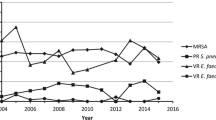Abstract
Bacterial resistance among Gram-negative pathogens is a challenging clinical problem. Tigecycline has been developed specifically to overcome resistance. The aim of this study was to assess the in vitro activity of tigecycline against ESBL-producing Escherichia coli, ESBL-producing Klebsiella spp., and multidrug-resistant Enterobacter spp. Between May 2007 and March 2008, 26 strains of ESBL-producing Escherichia coli, 10 strains of ESBL-producing Klebsiella spp., and 27 strains of multidrug-resistant Enterobacter spp. were isolated consecutively from inpatients with a documented infection in which the collected isolate was identified as the probable causative organism. The in vitro susceptibility against tigecycline was measured by the E-test method. MIC50 values were 1 µg/ml, 2 µg/ml, and 3 µg/ml respectively. MIC90 values were respectively 1.5 µg/ml, 4 µg/ml, and 12 µg/ml. Nonsusceptibility rates of 35%, 100%, and 96% respectively were found using EUCAST breakpoints. Despite the limited number of strains tested, our in vitro data suggest that tigecycline is unsuitable for the treatment of infections with multidrug-resistant Enterobacteriaceae in our setting. Therefore, we suggest that larger multicenter studies should be conducted to reconsider the value of tigecycline for the treatment of infections with multidrug-resistant, Gram-negative bacteria.

Similar content being viewed by others
References
Gaynes R, Edwards JR (2005) Overview of nosocomial infections caused by gram-negative bacilli. Clin Infect Dis 41:848–854 doi:10.1086/432803
Livermore DM (2003) Bacterial resistance: origins, epidemiology, and impact. Clin Infect Dis 36:11–23 doi:10.1086/344654
Livermore DM (2004) The need for new antibiotics. Clin Microbiol Infect 10:1–9 doi:10.1111/j.1465–0691.2004.1004.x
Stein GE, Craig WA (2006) Tigecycline: a critical analysis. Clin Infect Dis 43:518–524 doi:10.1086/505494
Hawkey P, Finch R (2007) Tigecycline: in-vitro performance as a predictor of clinical efficacy. Clin Microbiol Infect 13:354–362 doi:10.1111/j.1469–0691.2006.01621.x
Noskin GA (2005) Tigecycline: a new glycylcycline for treatment of serious infections. Clin Infect Dis 41:303–314 doi:10.1086/431672
Pankey GA (2005) Tigecycline. J Antimicrob Chemother 56:470–480 doi:10.1093/jac/dki248
Kiratisin P, Tiengrim S, Yungyuen T et al (2006) In vitro activity of colistin and tigecycline against extended-spectrum-beta-lactamase (ESBL)-producing Escherichia coli and Klebsiella pneumoniae isolated from patients in Siriraj hospital. J Infect Dis Antimicrob Agents 23:21–24
Brown SD, Traczewski MM (2007) Comparative in vivo antimicrobial activity of tigecycline, a new glycylcycline compound, in freshly prepared medium and quality control. J Clin Microbiol 45:2173–2179 doi:10.1128/JCM.02351–06
Wayne PA (2005) Clinical and Laboratory Standards Institute (CLSI)/NCCLS. Performance Standards for Antimicrobial Susceptibility Testing; fifteenth informational supplement, (M100-S15). CLSI 25
Pillar CM, Draghi DC, Dowzicky MJ et al (2008) In vitro activity of tigecycline against Gram-positive and Gram-negative pathogens as evaluated by broth microdilution and E-test. J Clin Microbiol. Available via http://jcm.asm.org/cgi/reprint/JCM.00637-08v1 Accessed 12 August 2008
Bolmström A, Karlsson A, Engelhardt A et al (2007) Validation and reproducibility assessment of tigecycline MIC determinations by Etest. J Clin Microbiol 45:2474–2479 doi:10.1128/JCM.00089–07
European Committee on Antimicrobial Susceptibility Testing (EUCAST) Steering Committee (2006) EUCAST technical note on tigecycline. Clin Microbiol Infect 11:1147–1149
Morosini MI, Garcia-Castillo M, Coque TM et al (2006) Antibiotic coresistance in extended-spectrum-β-lactamase-producing Enterobacteriaceae and in vitro activity of tigecycline. Antimicrob Agents Chemother 50:2695–2699 doi:10.1128/AAC.00155–06
Rodloff AC, Leclercq R, Debbia EA et al (2008) Comparative analysis of antimicrobial susceptibility among organisms from France, Germany, Italy, Spain and the UK as part of the tigecycline evaluation and surveillance trial. Clin Microbiol Infect 4:307–314 doi:10.1111/j.1469–0691.2007.01943.x
Hope R, Warner M, Potz NA et al (2006) Activity of tigecycline against ESBL-producing and AmpC-hyperproducing Enterobacteriaceae from South-East England. J Antimicrob Chemother 58:1312–1314 doi:10.1093/jac/dkl414
Glupczynski Y, Berhin H, Rodriguez-Villalobos H, Struelens M, Jans B, The Belgian Infection Society (2007) Epidemiology of extended-spectrum β-lactamase-producing Enterobacteriaceae in Belgium: preliminary results of a national multicentre survey in 2006. In: Program and abstracts of the 17th European Congress of Clinical Microbiology and Infectious Diseases. Abstract no. P-1355
Dean CR, Visalli MA, Projan SJ et al (2003) Efflux-mediatec resistance to tigecycline (GAR-936) in Pseudomonas aeruginosa PAO1. Antimicrob Agents Chemother 47:972–978 doi:10.1128/AAC.47.3.972–978.2003
Visalli MA, Murphy E, Projan SJ et al (2003) AcrAB multidrug efflux pump is associated with reduced levels of susceptibility to tigecycline (GAR-936) in Proteus mirabilis. Antimicrob Agents Chemother 47:665–669 doi:10.1128/AAC.47.2.665–669.2003
Ruzin A, Visalli MA, Keeney D et al (2005) Influence of transcriptional activator RamA on expression of multidrug efflux pump AcrAB and tigecycline susceptibility in Klebsiella pneumoniae. Antimicrob Agents Chemother 49:1017–1022 doi:10.1128/AAC.49.3.1017–1022.2005
Komatsu T, Ohta M, Kido N (1990) Molecular characterization of an Enterobacter cloacae gene (romA) which pleiotropically inhibits the expression of Escherichia coli outer membrane proteins. J Bacteriol 172:4082–4089
Babinchak T, Ellis-Grosse E, Dartois N et al (2005) The efficacy and safety of tigecycline for the treatment of complicated intra-abdominal infections: analysis of pooled clinical trial data. Clin Infect Dis 41:354–367 doi:10.1086/431676
Ellis-Grosse EJ, Babinchak T, Dartois N et al (2005) The efficacy and safety of tigecycline in the treatment of skin and skin-structure infections: results of 2 double-blind phase 3 comparison studies with vancomycin-aztreonam. Clin Infect Dis 41:341–353 doi:10.1086/431675
Anthony KA, Fishman NO, Linkin DR et al (2008) Clinical and microbiological outcomes of serious infections with multidrug-resistant gram-negative organisms treated with tigecycline. Clin Infect Dis 46:567–570 doi:10.1086/526775
Author information
Authors and Affiliations
Corresponding author
Rights and permissions
About this article
Cite this article
Naesens, R., Ursi, J.P., Van Schaeren, J. et al. In vitro activity of tigecycline against multidrug-resistant Enterobacteriaceae isolates from a Belgian hospital. Eur J Clin Microbiol Infect Dis 28, 381–384 (2009). https://doi.org/10.1007/s10096-008-0629-9
Received:
Accepted:
Published:
Issue Date:
DOI: https://doi.org/10.1007/s10096-008-0629-9




